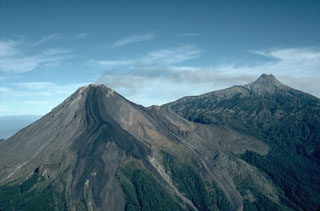Report on Colima (Mexico) — June 2000
Bulletin of the Global Volcanism Network, vol. 25, no. 6 (June 2000)
Managing Editor: Richard Wunderman.
Colima (Mexico) Low seismicity August 1999-May 2000; frequent explosions and evacuations
Please cite this report as:
Global Volcanism Program, 2000. Report on Colima (Mexico) (Wunderman, R., ed.). Bulletin of the Global Volcanism Network, 25:6. Smithsonian Institution. https://doi.org/10.5479/si.GVP.BGVN200006-341040
Colima
Mexico
19.514°N, 103.62°W; summit elev. 3850 m
All times are local (unless otherwise noted)
The following summarizes activity at Colima during the period from August 1999 to May 2000. As previously mentioned (BGVN 24:08), outbursts occurred on 5 and 17 July 1999. However, in the months that followed, August 1999 through May 2000, little activity occurred on Colima. Microearthquakes, sporadic eruptions and lahars were the most common events during these months.
During August through December 1999 Colima maintained low levels of seismicity, with few explosions or mudflows. Due to heavy precipitation on 2 September a lahar traveled under the Cordoban bridge without causing damage. Residents of Yerbabuena, La Becerrera, and Rancho El Jabali were told to avoid activities on the S-flank stream beds of the Cordoban, La Lumbre, San Antonio, and Montegrande rivers.
Landslides and lahars on the S and SW flanks during 5-6 September were quickly dispersed into La Lumbre and Cordoban drainages due to intense rains. Other monitored parameters showed no significant changes. During the week of 10 September seismicity remained low, with no degassing events or important explosions noted.
On 6 October at about 0120, residents from the village La Yerbabuena (8 km SW of the summit) reported a very short and light ashfall. The ashfall lasted only a few minutes, and prior to the fall residents reportedly heard "jet" sounds coming from the crater. Before the described events, the telemetered seismic network alerted the civil protection authorities, who then notified nearby villages of the activity. At 1700 on 12 October there were ground reports of an eruption that sent an ash cloud ~6 km.
During the first two weeks of November Colima ejected steam-and-ash an average of once per day. The estimated height of the columns varied from 200 to 1,000 m above the summit. Neither ballistic ejecta nor pyroclastic flows were observed. On 17 December seismicity remained stable, but some fumarolic and explosive emissions took place.
Beginning in January and continuing through May, ash explosions and steam emissions became frequent. Seismicity on 18 March remained low, yet Colima continued to produce fumes and explosions that were considered to be a high risk to the surrounding population. The evacuation of populations within a radius of 6.5-8.5 km from the summit was maintained by the State Systems of Civil Protection and the Mexican Army. After some explosions on 25 May these evacuations were again enforced.
Geological Summary. The Colima complex is the most prominent volcanic center of the western Mexican Volcanic Belt. It consists of two southward-younging volcanoes, Nevado de Colima (the high point of the complex) on the north and the historically active Volcán de Colima at the south. A group of late-Pleistocene cinder cones is located on the floor of the Colima graben west and east of the complex. Volcán de Colima (also known as Volcán Fuego) is a youthful stratovolcano constructed within a 5-km-wide scarp, breached to the south, that has been the source of large debris avalanches. Major slope failures have occurred repeatedly from both the Nevado and Colima cones, producing thick debris-avalanche deposits on three sides of the complex. Frequent recorded eruptions date back to the 16th century. Occasional major explosive eruptions have destroyed the summit (most recently in 1913) and left a deep, steep-sided crater that was slowly refilled and then overtopped by lava dome growth.
Information Contacts: Colima Volcano Observatory, University of Colima, Ave. 25 de Julio 965, Colima 28045 México (URL: https://portal.ucol.mx/cueiv/).

